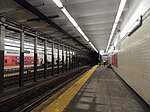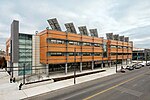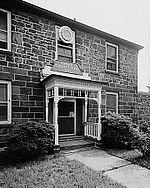University Heights, Newark

University Heights is a neighborhood in Newark in Essex County, New Jersey. It is so named because of the four academic institutions located within its boundaries: Rutgers University (Newark Campus), New Jersey Institute of Technology (NJIT), New Jersey Medical School (Rutgers) and Essex County College. In total, the schools enroll approximately 32,000 degree-seeking students. The University Heights neighborhood is roughly bounded by University Avenue to the east, Orange Street to the north, Bergen Street to the west, and South Orange Avenue to the south. The schools are involved in the development of University Heights Science Park, a major research complex to be located between their campuses. The Public Health Research Institute on Warren Street relocated there in 2002. The area is home to Science Park High School as well. BioTrials, a French biological research company is one of the first firms to locate there. They are located in a seven story newly constructed building on Norfolk St. Rutgers and NJIT were expanded considerably beginning in the 1960s. Prior to this expansion, University Heights was a relatively affluent residential neighborhood of Newark. The area has one of Newark's few concentrations of brownstones. The gym at Essex County College was home of the American Basketball Association team, the Newark Express, which moved to Drew University and became the Jersey Express after averaging some 150 fans per game in Newark, though it attracted even fewer at Drew. The area is home to the Paul Robeson Galleries at Rutgers University and the Weston Museum in the Van Houten Library at the New Jersey Institute of Technology, which includes artifacts from inventor Edward Weston, an early challenger of Thomas Edison.One of the main north-south thoroughfares of University Heights is Martin Luther King, Jr. Blvd. (formerly High Street) home to many historic buildings. Eberhardt Hall at NJIT, St. Mary's Abbey Church, Essex County Hall of Records, and Essex County Veterans Courthouse are among Newark's registered historic places, as is the former Essex County Jail. The neighborhood is served by the Washington Street, Warren Street/NJIT, and Norfolk Street stations of Newark's Light Rail which links to Manhattan via the PATH and NJTransit rail systems at Newark's Penn Station.
Excerpt from the Wikipedia article University Heights, Newark (License: CC BY-SA 3.0, Authors, Images).University Heights, Newark
Cornerstone Lane, Newark
Geographical coordinates (GPS) Address Nearby Places Show on map
Geographical coordinates (GPS)
| Latitude | Longitude |
|---|---|
| N 40.741111111111 ° | E -74.183055555556 ° |
Address
Society Hill Pool
Cornerstone Lane
07103 Newark
New Jersey, United States
Open on Google Maps






